Travels with The Style Saloniste: Hurtling into the unknown in Quito, Ecuador, I recently stayed for a few days at the glamorous Casa Gangotena hotel, which I loved. It is in the center of town, and is itself an historic building dating to the eighteenth century.
Come with me to Quito this week—and discover historic churches and ravishing cathedral interiors from the seventeenth century that are gilded, baroque, and beyond beautiful. I discovered on this very impromptu adventure a surprising historic town and a gracious hotel with views and rooms to love.
I’ve been working on many a deadline this year, and I love to leap from one great new book and writing project to another.
Then I found that I wanted to disappear for a few days. Ecuador had been on my mind for some time because it’s less traveled. I’ve seen few images of it, and I wanted to throw myself into some mysteries.
Thus—after about twelve hours in transit, from San Francisco-Houston—I landed in Quito, Ecuador, at 10,000 feet altitude in the Andes. (For quick reference—it’s on about the same longitude as New York.)
My first adventure upon arriving in Quito at the Casa Gangotena was to go up to the hotel roof terrace to see a vista I’d never seen.
That’s the St. Francis cathedral (I have fantastic shots of the gold-struck interiors below), and you can see the Andes rearing up beyond the steeples. The clouds were great thunderheads that charged through the sky, and the air is especially bright at this altitude. Clarity is one first impression. Brightness. Clear air. And then the feeling of seeing something of which I’d never seen a picture. Buddha mind. Lightness.
I could not wait to explore. Come with be to discover old town Quito, a UNESCO-protected historic center, with its intensely dramatic interiors. You’ll also meet the hotel I stayed at, which was charming, polished, and very welcoming.
Come to visit the town and its religious buildings and markets. I promise you gold, artistry and surprises.
In Quito, I chose to stay in the Casa Gangotena, which opened in 2011. It’s in the historic center, which has about a dozen significant churches, chapels, cathedrals, and monasteries and religious monuments. They date from the 16th century, and several took a century to complete. You can see several from the hotel.
Quito’s historic old town is the largest and best-restored in the Americas and was UNESCO’s first World Heritage Site city.
Everything is close to the hotel. Walking with my very charming guide, I headed first to the St. Francis church. I discovered living treasures.
For two days, with two different guides, I explored the historic churches and cathedrals.
I wanted to see the architecture, and dive into buildings of majestic and apparent devotion, craftsmanship, artistry, wild beauty, and cultural importance.
St. Francisco church adjacent to the Casa Gangotena hotel, is so intensely beautiful, I became rather addicted to the interior. Every inch and centimeter is burnished with gold. The invading Spanish discovered the gold mines, so there was lots of it.

In the church interiors, hundreds of portraits, sculptures, odd stairways, Saracenic carving, Moorish arches, niches, domes, chapels, volutes, architraves, articulated frames, polychrome, transepts, Mudejar characteristics, angels, nuns, gargoyles, saints, floreate corbels, and pulpits and knaves and aedicules were all painted and slathered in thick gold layers. Much of it is by Ecuadorian artists. Dazzling. Hallucinogenic. Dizzying. The eye is traveling, indeed. I’ve never seen church interiors so intensely embellished.
At a certain point, after we had walked around several churches, each one dazzling and shot with gold, light glancing and ricocheting off each surface, I sat in a pew to gaze. I mused, I observed and took it all in.
And I thought I might get Stendhal syndrome. Think E. M. Forster, 'A Room with a View'. 1908, Lucy Honeychurch visiting churches in Florence, viewing multitudes of embellishments, naked figures, saints, shimmering altars and art of religious fervor. Lucy fainted. I did not faint…and went back for more the following day.
Metropolitan Touring also arranged a vivid afternoon walking visit to produce markets, spice shops, local bakeries and endearing and charming cafés and chocolate shops, a craft gallery, and an old town of great charm. Vegetables and fruit in Ecuador seem to be brighter, more flavored, more intense, and more luscious. Perhaps it is the altitude. I think it’s the great Andean soil.
The locale’s history stretches back to the time of the Incas, when the square featured Inca temples. The Franciscan order then occupied the whole western hillside of the square, which had for centuries been used as a giant Indian open-air market for traders from every region.
Due to the importance of the Plaza San Francisco in the following centuries, various wealthy families built their homes around it, among them Casa Gangotena.
The Casa, in its last incarnation dates from 1926. It’s included in Quito’s list of heritage properties.
I liked the residential feeling of the hotel—and the sense of history.
The décor is classical in feeling, with flourishes of Baroque interiors in the mansion’s three floors.
The renovation was done with great respect for the original history, but with a light touch.
Attention-to-detail during restoration has been exceptional, maintaining nearly all of the house’s original architectural features. These include its tall, elegant windows, which provide views of the Panecillo hillside, the plaza and the inner courtyard.
Suites and rooms are particularly comfortable for a traveler and bathrooms are unusually spacious.
A lobby full of exotic Ecuadorian flowers, a garden-patio brimming with orchids and native plants, and a sunny dining room are ideal for enjoying culinary experiences. The chef has made a point of focusing on inspirations from Ecuadorian dishes and local ingredients. I found the cuisine light, modern, and creative.
The rooftop terrace with wrap-around views of the historic centre’s towers, tiles and spires is spot to watch the frequent religious and cultural events on the square below.
A decade-long investment to regenerate Quito’s rich historic centre has restored its cobblestone plazas and gleaming church interiors, opening up previously run-down areas of the Old Town.
Quito is an ideal stopover en route to the Galápagos Islands. In a two or three-day visit, it's possible to take this essential walking tour to visit local businesses such as the seamstress who makes the clothes for dozens of baby Jesus statues, the local milliner and his shop of multifarious and multi-colored hats, the café serving traditional Ecuadorian filter coffee, shops and traditional sweet-makers.
On Calle Rocafuerte, past historic residences, stands the San Francisco Market, one of the oldest in the capital, selling vibrant-colored exotic fruit and Ecuadorian roses, herbs.
I also enjoyed the emblematic street La Ronda, where local artisans can be visited – including a young chocolatier – as well as the Plaza Grande main square and the stunning gold-leaf bedecked La Compañía de Jesús church.
A guided visit to the Casa del Alabado Archaeological Museum is part of the hands-on exploration. The museum houses a fantastic collection of pieces dating back some 5,000 years within a handsome restored 17th-century colonial mansion.
I ordered Earl Grey tea from a diverse selection of herb teas, black varieties, and scented teas. I especially like loose-leaf tea in a teapot with boiling water, already infused. Delicious.
We chose little sandwiches, and a selection of guava cheesecake, a chocolate brownie of Ecuadorian chocolate, and housemade chocolate ice cream.
On the menu were special Ecuadorean specialties with tropical fruit, heritage vegetables, rare tropical fruit, nuts, herbs and wild nettles, and great condiments like peppers as well as wild honey.
There were a few sprinkles of rain so we sat indoors overlooking the garden terrace.
I noted also that for after dinner, the hotel has an interesting selection of ports, sherry, Ecuadorian liqueurs, cognacs, grappa and sambuca.
It’s very relaxed and pleasant.
Also on the menu: Ecuador has splendidly rich volcanic soil—and harvests spectacular coffee and chocolate, along with
So it’s not surprising that Casa Gangotena chefs offer delicious salads and tropical fruit and exotic ingredients on all menus.
For breakfast, I requested fruit salad with plain yoghurt, along with a special estate grown coffee roasted at the Aguila de Oro roasting shop in old-town Quito.
I visited several crafts shops that had lovely weaving, and there is some pretty locally crafted jewelry on view.
But the special cargo in my luggage was two packages of premium Ecuadorean chocolates, along with two pounds of freshly roasted coffee from the Aguila de Oro, a five-minute walk from the hotel.
The Aguila de Oro roastery, proprietor Jordan V. Morales Espinosa, has been in the same family for over six decades. They still use the original roaster.
Simply, they roast and grind precisely one choice of top estate-grown coffee. No blends. There’s the roasting machine in the shop that roasts this single-estate bean, and there are bins of freshly roasted coffee beans. That’s it. It’s perfect. Oh, they do light, dark and ultra-light roasts. I recall it was very inexpensive. Perhaps the high altitude was kicking in, but I recall it was something like $10 per pound. Oh, and the owners are charming. The bold coffee aroma was …altitude effect perhaps...quite intense and somewhat hallucinogenic.
They don’t serve coffee or any drinks, and they don’t veer from their single-minded conviction that their Arabica coffee is the best in town. A shop full of clients suggested that everyone was happy with their focused style.
I brought the beans home, ground them, and made my morning coffee with a French press, fresh whole milk. It was heavenly. Rich, full-bodied and with a tinge of wine and chocolate flavors, the coffee lingered on the palate, reminding me of the history and cultural riches of Quito. It tasted of Ecuador.
I also love chocolate and discovered two specific premium organic Ecuadorean chocolate brands.
Pacari is perhaps the best of all. I love the 54 per cent cacao lemongrass-flavored bar, and the darker bars, but the Pacari bar that was super-special was the Raw chocolate, 70 per cent cacao. It’s perfect. The burst of pure chocolate fills your mouth, and the complex slightly earthy flavor lingers on the tongue. It’s like tasting chocolate—free of any fillers or added flavors—for the first time. It’s slightly…slightly …grainy, which makes smooth chocolates seem a bit boring. I highly recommend Pacari, which I had not seen or tasted before my Ecuador visit. I love fine chocolate and this is exceptional.
I also loved and admired the Kallari farmer-owned organic chocolate, and especially liked the 70 per cent bar, with a hint of vanilla. Kallari is certified biodynamic, which is impressive.
Kallari is an Ecuadorian co=operative of 850 Kichwa families from the Ecuadoran Amazon, and they cultivate heirloom cacao trees. Wonderful product. If you can find it, enjoy it with Prosecco or Port or Pinot Grigio. Lovely.
Doing some research on Kallari—I discovered that the co-op worked closely with German food technicians, and the late Dr. Robert Steinberg, a wonderful friend of mine who was the co-founder (with John Scharffenberger) of Scharffen Berger chocolate company. It is an unusually elegant product.
It is possible also to order bars of chocolate directly from the company. I know you will find them a vivid discovery.
www.pacarichocolate.com
www.kallari.com
Aguila de Oro coffee roasting:
Note that Ecuador is on the equator. (Ecuador is equator in Spanish, and the French name for Ecuador is Equateur.)
Quito is high in the Andes, at around 10,000 feet altitude. The weather is generally temperate year-round, and may be cool in the evening.
Casa Gangotena is located in the UNESCO-protected old-town area of Quito, and it offers an ideal starting point for a days’ visit to historic cathedrals, the presidential palace, markets, and restaurants, beautiful historic residences.
Altitude: I have trekked to 13,000 feet in the Himalayas on the Annapurna Circuit and did not feel any effect of the altitude. I climbed Mr. Kinabalu in Sabah, East Malaysia without incident. Before traveling to Ecuador, I read everything possible on altitude effects, and consulted my travel doctor. She said to take it easy at first, to drink lots of water, and to rest. I thought I might at least feel light-headed. I did not. I slept well, and did not feel breathless walking around, climbing stairs. I propose checking with your travel doctor before travel.
Come with me to Quito this week—and discover historic churches and ravishing cathedral interiors from the seventeenth century that are gilded, baroque, and beyond beautiful. I discovered on this very impromptu adventure a surprising historic town and a gracious hotel with views and rooms to love.
I’ve been working on many a deadline this year, and I love to leap from one great new book and writing project to another.
Then I found that I wanted to disappear for a few days. Ecuador had been on my mind for some time because it’s less traveled. I’ve seen few images of it, and I wanted to throw myself into some mysteries.
Thus—after about twelve hours in transit, from San Francisco-Houston—I landed in Quito, Ecuador, at 10,000 feet altitude in the Andes. (For quick reference—it’s on about the same longitude as New York.)
My first adventure upon arriving in Quito at the Casa Gangotena was to go up to the hotel roof terrace to see a vista I’d never seen.
| View from the roof terrace of the Casa Gangotena |
That’s the St. Francis cathedral (I have fantastic shots of the gold-struck interiors below), and you can see the Andes rearing up beyond the steeples. The clouds were great thunderheads that charged through the sky, and the air is especially bright at this altitude. Clarity is one first impression. Brightness. Clear air. And then the feeling of seeing something of which I’d never seen a picture. Buddha mind. Lightness.
I could not wait to explore. Come with be to discover old town Quito, a UNESCO-protected historic center, with its intensely dramatic interiors. You’ll also meet the hotel I stayed at, which was charming, polished, and very welcoming.
Come to visit the town and its religious buildings and markets. I promise you gold, artistry and surprises.
In Quito, I chose to stay in the Casa Gangotena, which opened in 2011. It’s in the historic center, which has about a dozen significant churches, chapels, cathedrals, and monasteries and religious monuments. They date from the 16th century, and several took a century to complete. You can see several from the hotel.
Quito’s historic old town is the largest and best-restored in the Americas and was UNESCO’s first World Heritage Site city.
Everything is close to the hotel. Walking with my very charming guide, I headed first to the St. Francis church. I discovered living treasures.
For two days, with two different guides, I explored the historic churches and cathedrals.
I wanted to see the architecture, and dive into buildings of majestic and apparent devotion, craftsmanship, artistry, wild beauty, and cultural importance.
St. Francisco church adjacent to the Casa Gangotena hotel, is so intensely beautiful, I became rather addicted to the interior. Every inch and centimeter is burnished with gold. The invading Spanish discovered the gold mines, so there was lots of it.

In the church interiors, hundreds of portraits, sculptures, odd stairways, Saracenic carving, Moorish arches, niches, domes, chapels, volutes, architraves, articulated frames, polychrome, transepts, Mudejar characteristics, angels, nuns, gargoyles, saints, floreate corbels, and pulpits and knaves and aedicules were all painted and slathered in thick gold layers. Much of it is by Ecuadorian artists. Dazzling. Hallucinogenic. Dizzying. The eye is traveling, indeed. I’ve never seen church interiors so intensely embellished.
At a certain point, after we had walked around several churches, each one dazzling and shot with gold, light glancing and ricocheting off each surface, I sat in a pew to gaze. I mused, I observed and took it all in.
And I thought I might get Stendhal syndrome. Think E. M. Forster, 'A Room with a View'. 1908, Lucy Honeychurch visiting churches in Florence, viewing multitudes of embellishments, naked figures, saints, shimmering altars and art of religious fervor. Lucy fainted. I did not faint…and went back for more the following day.
Metropolitan Touring also arranged a vivid afternoon walking visit to produce markets, spice shops, local bakeries and endearing and charming cafés and chocolate shops, a craft gallery, and an old town of great charm. Vegetables and fruit in Ecuador seem to be brighter, more flavored, more intense, and more luscious. Perhaps it is the altitude. I think it’s the great Andean soil.
About the Casa Gangotena Hotel
The new 31-suite Casa Gangotena hotel (named for one of the grand families that once occupied it) stands on the corner of Plaza San Francisco, the capital’s emblematic square.The locale’s history stretches back to the time of the Incas, when the square featured Inca temples. The Franciscan order then occupied the whole western hillside of the square, which had for centuries been used as a giant Indian open-air market for traders from every region.
Due to the importance of the Plaza San Francisco in the following centuries, various wealthy families built their homes around it, among them Casa Gangotena.
The Casa, in its last incarnation dates from 1926. It’s included in Quito’s list of heritage properties.
I liked the residential feeling of the hotel—and the sense of history.
The décor is classical in feeling, with flourishes of Baroque interiors in the mansion’s three floors.
Attention-to-detail during restoration has been exceptional, maintaining nearly all of the house’s original architectural features. These include its tall, elegant windows, which provide views of the Panecillo hillside, the plaza and the inner courtyard.
Suites and rooms are particularly comfortable for a traveler and bathrooms are unusually spacious.
A lobby full of exotic Ecuadorian flowers, a garden-patio brimming with orchids and native plants, and a sunny dining room are ideal for enjoying culinary experiences. The chef has made a point of focusing on inspirations from Ecuadorian dishes and local ingredients. I found the cuisine light, modern, and creative.
 |
Discovering Quito
Metropolitan Touring’s walking tours of Old Town Quito, Ecuador are co-designed with a grassroots NGO organization, the San Roque Heritage Guardians. A local resident guide describes the special wares --herbs, breads, weaving, costumes and people who live in the largest and best-restored historical centre in the Americas.A decade-long investment to regenerate Quito’s rich historic centre has restored its cobblestone plazas and gleaming church interiors, opening up previously run-down areas of the Old Town.
Quito is an ideal stopover en route to the Galápagos Islands. In a two or three-day visit, it's possible to take this essential walking tour to visit local businesses such as the seamstress who makes the clothes for dozens of baby Jesus statues, the local milliner and his shop of multifarious and multi-colored hats, the café serving traditional Ecuadorian filter coffee, shops and traditional sweet-makers.
On Calle Rocafuerte, past historic residences, stands the San Francisco Market, one of the oldest in the capital, selling vibrant-colored exotic fruit and Ecuadorian roses, herbs.
I also enjoyed the emblematic street La Ronda, where local artisans can be visited – including a young chocolatier – as well as the Plaza Grande main square and the stunning gold-leaf bedecked La Compañía de Jesús church.
A guided visit to the Casa del Alabado Archaeological Museum is part of the hands-on exploration. The museum houses a fantastic collection of pieces dating back some 5,000 years within a handsome restored 17th-century colonial mansion.
Tea at Casa Gangotena
Late in the afternoon, after visiting cathedrals, markets, and art galleries and palaces, it is incredibly pleasant to sit down with a friend for afternoon tea at the Casa Gangotena.I ordered Earl Grey tea from a diverse selection of herb teas, black varieties, and scented teas. I especially like loose-leaf tea in a teapot with boiling water, already infused. Delicious.
We chose little sandwiches, and a selection of guava cheesecake, a chocolate brownie of Ecuadorian chocolate, and housemade chocolate ice cream.
On the menu were special Ecuadorean specialties with tropical fruit, heritage vegetables, rare tropical fruit, nuts, herbs and wild nettles, and great condiments like peppers as well as wild honey.
There were a few sprinkles of rain so we sat indoors overlooking the garden terrace.
I noted also that for after dinner, the hotel has an interesting selection of ports, sherry, Ecuadorian liqueurs, cognacs, grappa and sambuca.
It’s very relaxed and pleasant.
Also on the menu: Ecuador has splendidly rich volcanic soil—and harvests spectacular coffee and chocolate, along with
So it’s not surprising that Casa Gangotena chefs offer delicious salads and tropical fruit and exotic ingredients on all menus.
For breakfast, I requested fruit salad with plain yoghurt, along with a special estate grown coffee roasted at the Aguila de Oro roasting shop in old-town Quito.
What to Bring Home
I visited several crafts shops that had lovely weaving, and there is some pretty locally crafted jewelry on view.But the special cargo in my luggage was two packages of premium Ecuadorean chocolates, along with two pounds of freshly roasted coffee from the Aguila de Oro, a five-minute walk from the hotel.
The Aguila de Oro roastery, proprietor Jordan V. Morales Espinosa, has been in the same family for over six decades. They still use the original roaster.
Simply, they roast and grind precisely one choice of top estate-grown coffee. No blends. There’s the roasting machine in the shop that roasts this single-estate bean, and there are bins of freshly roasted coffee beans. That’s it. It’s perfect. Oh, they do light, dark and ultra-light roasts. I recall it was very inexpensive. Perhaps the high altitude was kicking in, but I recall it was something like $10 per pound. Oh, and the owners are charming. The bold coffee aroma was …altitude effect perhaps...quite intense and somewhat hallucinogenic.
They don’t serve coffee or any drinks, and they don’t veer from their single-minded conviction that their Arabica coffee is the best in town. A shop full of clients suggested that everyone was happy with their focused style.
I brought the beans home, ground them, and made my morning coffee with a French press, fresh whole milk. It was heavenly. Rich, full-bodied and with a tinge of wine and chocolate flavors, the coffee lingered on the palate, reminding me of the history and cultural riches of Quito. It tasted of Ecuador.
I also love chocolate and discovered two specific premium organic Ecuadorean chocolate brands.
Pacari is perhaps the best of all. I love the 54 per cent cacao lemongrass-flavored bar, and the darker bars, but the Pacari bar that was super-special was the Raw chocolate, 70 per cent cacao. It’s perfect. The burst of pure chocolate fills your mouth, and the complex slightly earthy flavor lingers on the tongue. It’s like tasting chocolate—free of any fillers or added flavors—for the first time. It’s slightly…slightly …grainy, which makes smooth chocolates seem a bit boring. I highly recommend Pacari, which I had not seen or tasted before my Ecuador visit. I love fine chocolate and this is exceptional.
I also loved and admired the Kallari farmer-owned organic chocolate, and especially liked the 70 per cent bar, with a hint of vanilla. Kallari is certified biodynamic, which is impressive.
Kallari is an Ecuadorian co=operative of 850 Kichwa families from the Ecuadoran Amazon, and they cultivate heirloom cacao trees. Wonderful product. If you can find it, enjoy it with Prosecco or Port or Pinot Grigio. Lovely.
Doing some research on Kallari—I discovered that the co-op worked closely with German food technicians, and the late Dr. Robert Steinberg, a wonderful friend of mine who was the co-founder (with John Scharffenberger) of Scharffen Berger chocolate company. It is an unusually elegant product.
It is possible also to order bars of chocolate directly from the company. I know you will find them a vivid discovery.
www.pacarichocolate.com
www.kallari.com
Aguila de Oro coffee roasting:
Traveling to Quito
Traveling to Quito, Ecuador, from North American, Europe and South America is very straightforward. There are many direct flights from Europe, and from cities like Houston and Miami, Rio de Janeiro and Bogota. From Houston to Quito is approximately five hours flying time.Note that Ecuador is on the equator. (Ecuador is equator in Spanish, and the French name for Ecuador is Equateur.)
Quito is high in the Andes, at around 10,000 feet altitude. The weather is generally temperate year-round, and may be cool in the evening.
Casa Gangotena is located in the UNESCO-protected old-town area of Quito, and it offers an ideal starting point for a days’ visit to historic cathedrals, the presidential palace, markets, and restaurants, beautiful historic residences.
Altitude: I have trekked to 13,000 feet in the Himalayas on the Annapurna Circuit and did not feel any effect of the altitude. I climbed Mr. Kinabalu in Sabah, East Malaysia without incident. Before traveling to Ecuador, I read everything possible on altitude effects, and consulted my travel doctor. She said to take it easy at first, to drink lots of water, and to rest. I thought I might at least feel light-headed. I did not. I slept well, and did not feel breathless walking around, climbing stairs. I propose checking with your travel doctor before travel.
And remember:
“The most beautiful thing we can experience is the mysterious. It is the source of all true art and science.”—Albert Einstein
For More Information:
Metropolitan Touring in Ecuador
Metropolitan Touring in Ecuador
www.metropolitan-touring.com
The Metropolitan Touring company is the one to know for travel within Ecuador, as well as to the Galapagos, Patagonia, and throughout South American. I was most impressed. I was also loved the guides provided by the company for walking tours of old-town Quito, in the historic district. They were great company, knowledgeable about infinite and complex details of colonial architecture, offered insight into complex history, and spoke of religious orders that arrived in Ecuador, religious portraits and symbolism. Intrepid explorers, they guided me to buildings of great architectural interest that are not open to the public, and chapels and galleries and historic monuments of great beauty.
The Metropolitan Touring company is the one to know for travel within Ecuador, as well as to the Galapagos, Patagonia, and throughout South American. I was most impressed. I was also loved the guides provided by the company for walking tours of old-town Quito, in the historic district. They were great company, knowledgeable about infinite and complex details of colonial architecture, offered insight into complex history, and spoke of religious orders that arrived in Ecuador, religious portraits and symbolism. Intrepid explorers, they guided me to buildings of great architectural interest that are not open to the public, and chapels and galleries and historic monuments of great beauty.
Casa Gangotena
Bolivar Oe6-41 y Cuenca
Quito, Ecuador
www.casagangotena.com/en/
Credits:
Image of view from roof terrace at Casa Gangotena by Diane Dorrans Saeks.
Images of Casa Gangotena courtesy Casa Gangotena, used here with permission.
Credits:
Image of view from roof terrace at Casa Gangotena by Diane Dorrans Saeks.
Images of Casa Gangotena courtesy Casa Gangotena, used here with permission.


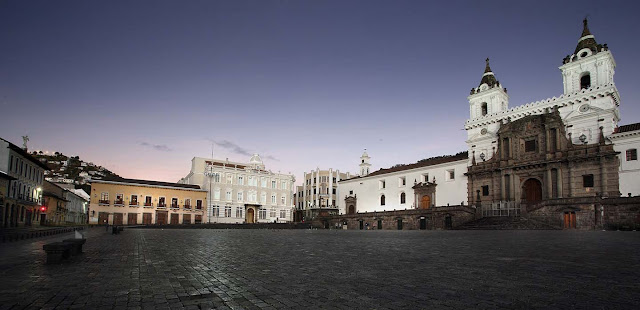
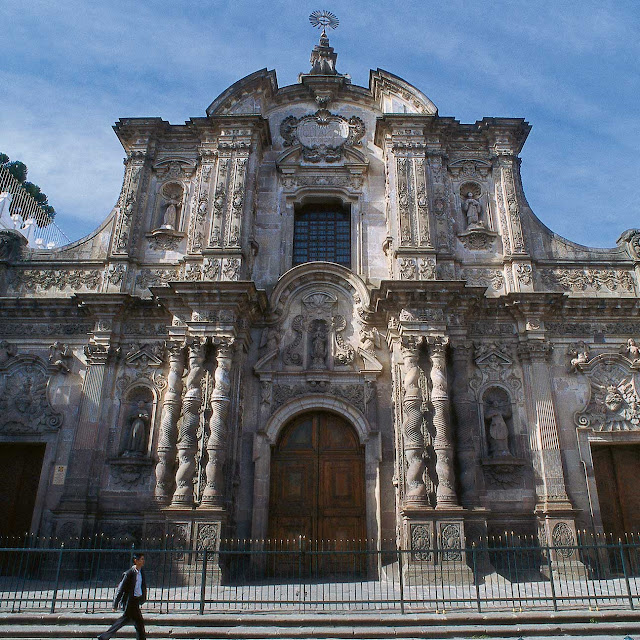


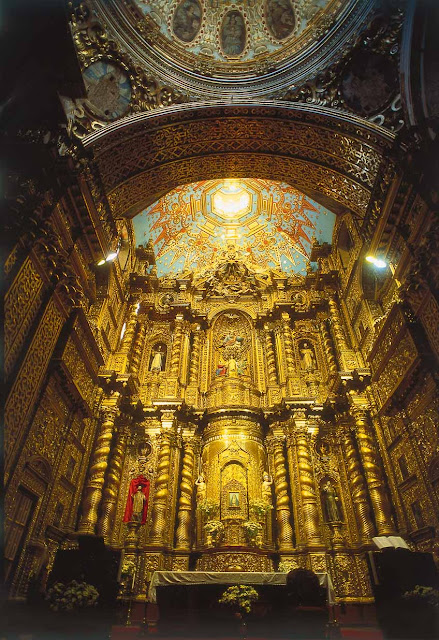

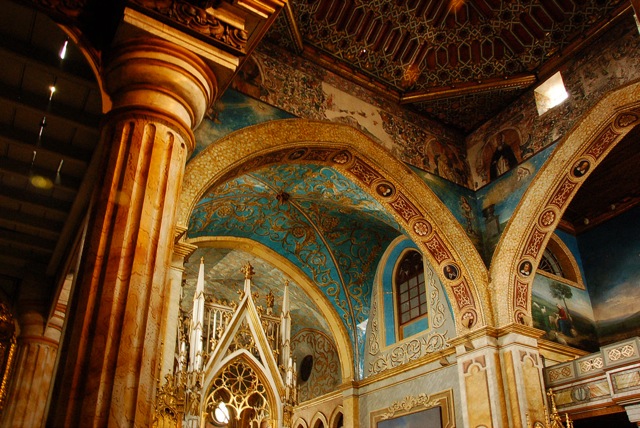


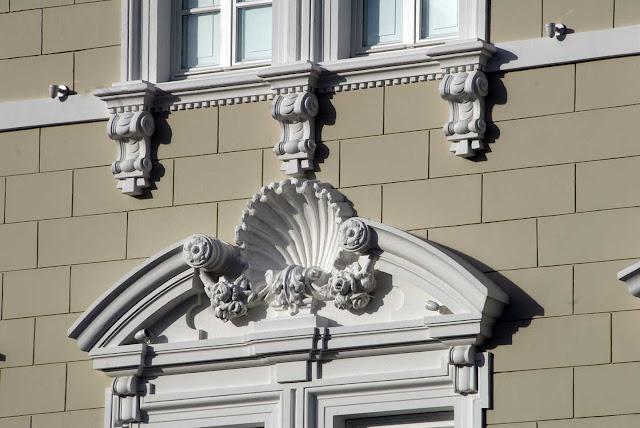




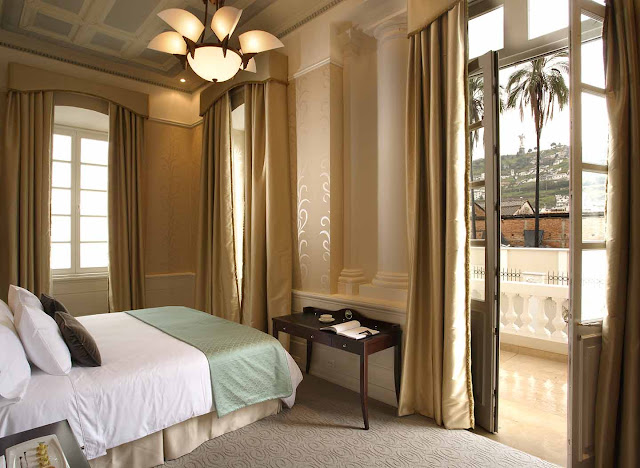
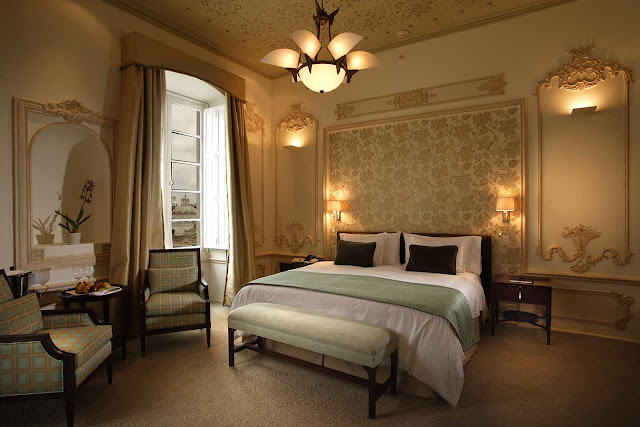


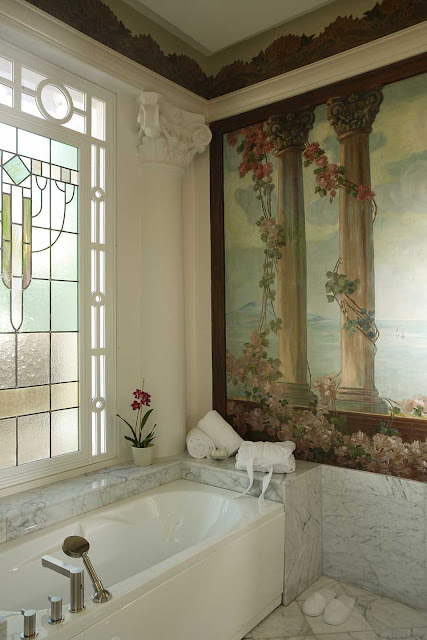

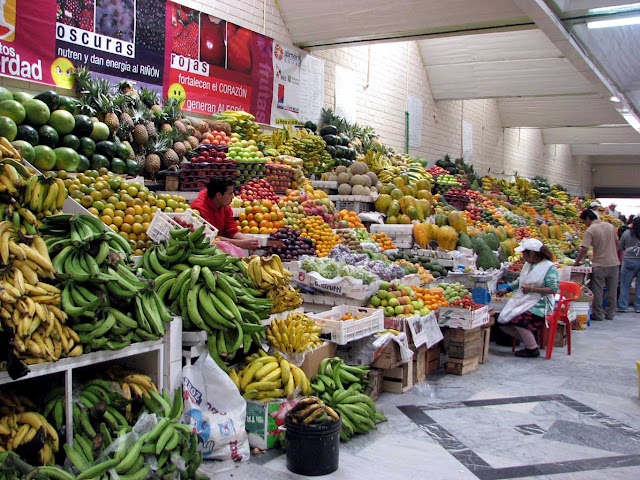
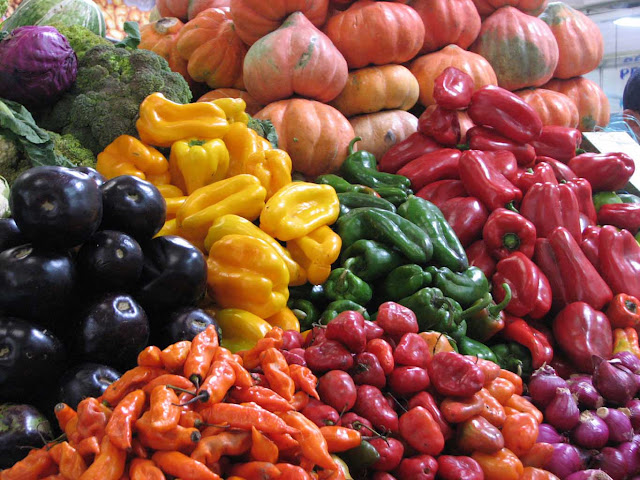


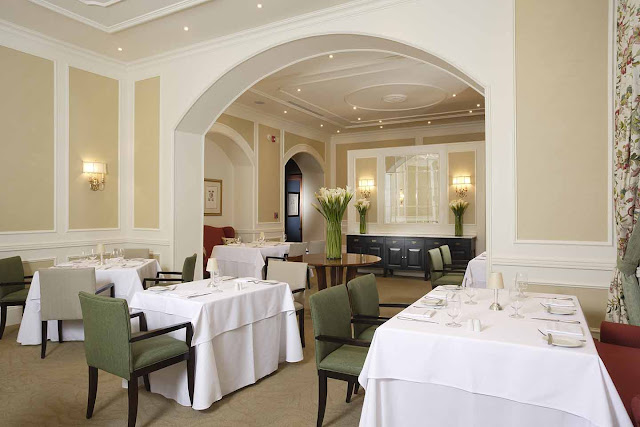
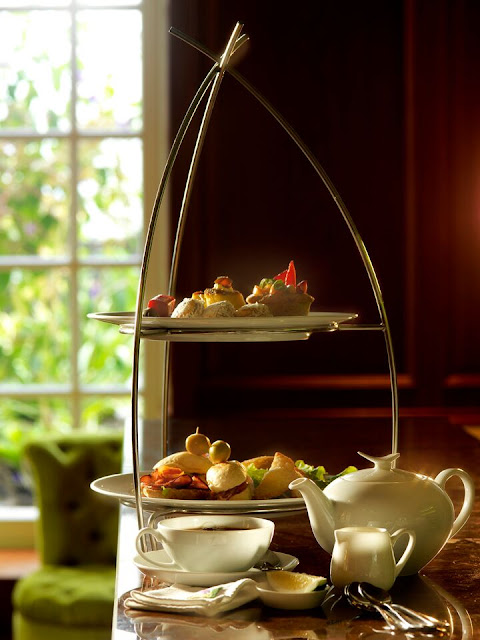

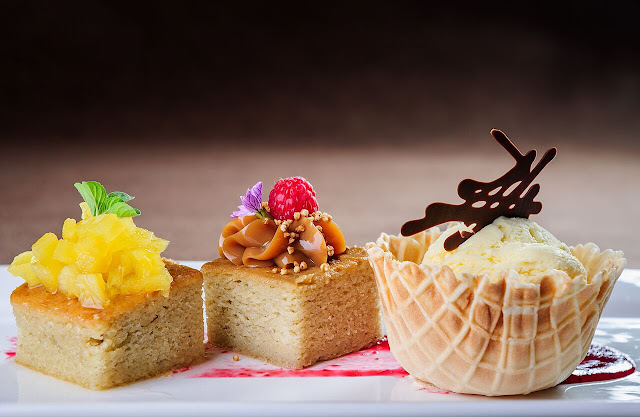
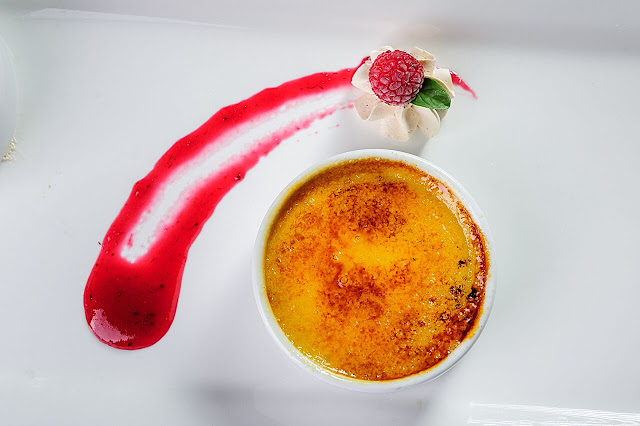
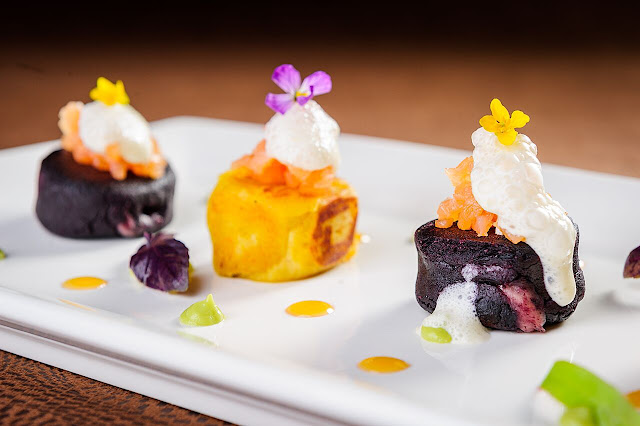


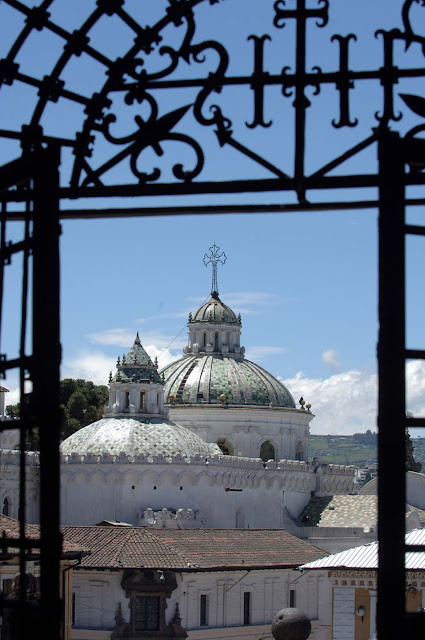
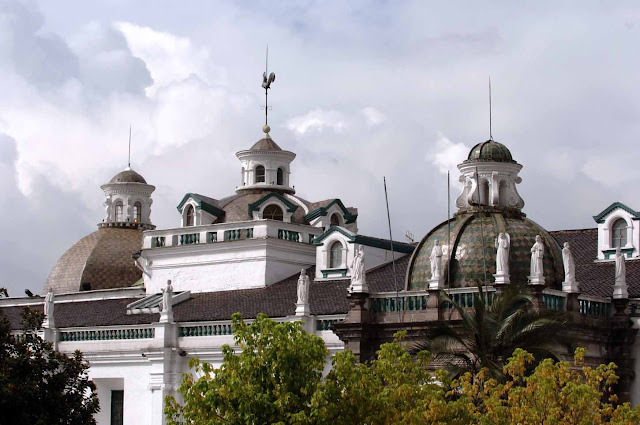


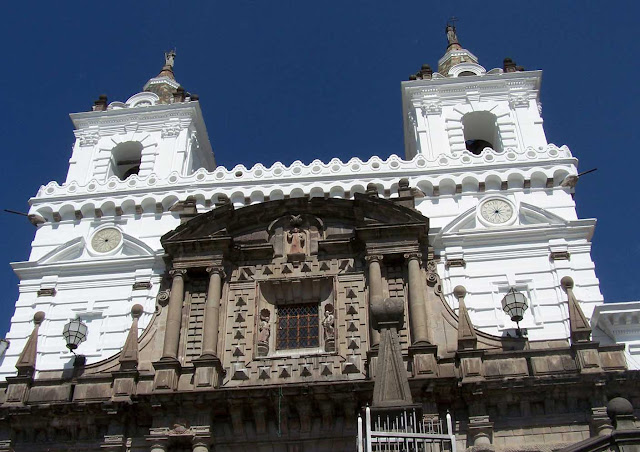
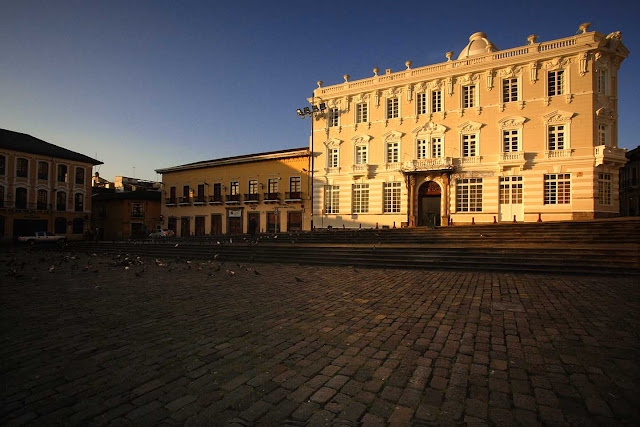
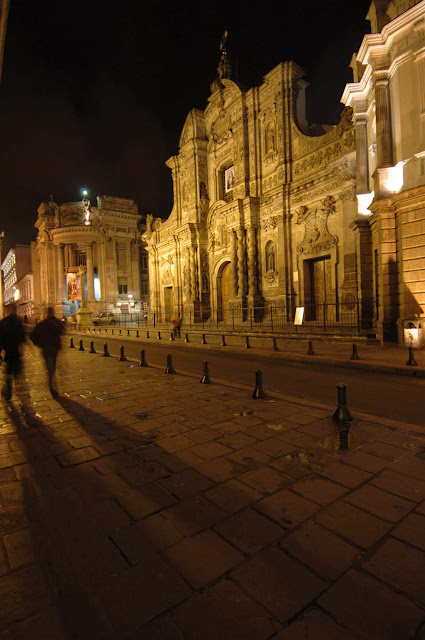
1 comment:
Thank you for sharing your Latest travel experience. now, I'm craving a piece of chocolate!
Karen
Post a Comment